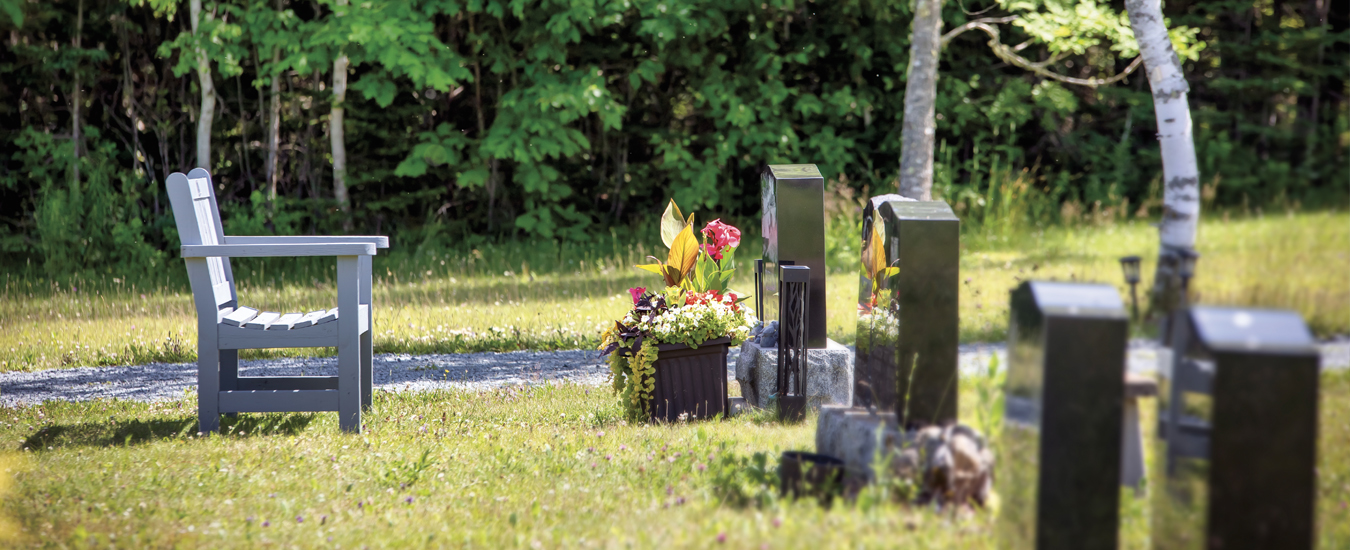The images are iconic. A veiled woman dressed in black crying into a lace handkerchief while the hushed voices and solemn expressions of her family and friends surround her, six men shouldering a casket into a hearse before depositing it in the ground and dirt (and, possibly, one red rose) hits the lid.
Iconic, but as far from alive as the body in the casket. In a world where everything has changed, should we be surprised if even death doesn’t work the way it used to?
Nowadays pallbearers, if there are any, are as likely to wear golf shirts as black suits. Even the minimalist black arm bands are defunct. And since more than 75 per cent of funerals in Canada involve cremation or aquamation, there’s no casket to bury. Visitations have either been shortened or dispensed with altogether and funerals happen when it’s convenient for everyone to get together.
Michael Goodyear owns Central Funeral and Cremation Services in Grand Falls-Windsor, N.L. In his 48 years in the business, he’s seen the changes and instituted a few of them himself. He’s gone from routinely draping a coffin in black velvet as it sits in the front parlour of the deceased’s home to holding funerals where he’s never met the family in person — everything done online.
Goodyear isn’t alone. Almost every funeral parlour website has a section outlining what survivors can do to personalize their loved one’s funeral. Things are no longer left in the hands of the funeral director or clergy. Services are becoming a celebration of life with photos, videos, and multiple eulogies rather than a solemn religious ceremony following an established formula.
And then there’s dying. We don’t do that like in times past either.
Michelle Abe needed help. She had a 10-year-old son, the world was in lockdown, and she had learned that her husband, Glen Cowen, was dying. “My husband had a terminal illness and it was during COVID and he was debating whether or not to do MAiD (Medical Assistance in Dying). I was searching for answers to help him and learned about death doulas. I had used a doula when I gave birth and it was really helpful to have someone to help navigate me through this. We have people who help us with everything. Why not this?”
Heather Spratt, based in St. John’s, N.L., is the doula who helped Michelle and Glen negotiate his dying. She sees her role pragmatically. “You have professionals to provide all kinds of services. We use an accountant, a landscaper. Why would you go through such a major life event without help? We’re here to make a difficult time easier for everyone.”
Learning there was such a person might have been news to Abe, but end-of-life doulas (as they prefer to be called) have been around for thousands of years, at least unofficially. Back in the days when people died in their own multi-generational homes, there was always someone whose job it was to attend to them. Nowadays, with fewer generations living together and more people working outside the home, the situation has changed. And support networks have sprung up to meet those changing needs and expectations.
According to the website of the End of Life Doula Association of Canada the job is, “Providing personalized end-of-life care, advocacy, community awareness, and support.” With the exception of medical tasks, they do just about everything necessary for the person who is dying and those around them who are affected. Their services are increasingly sought after. Before COVID there were about 50 end-of-life doulas in Canada. Now there are more than 500. While they are most common on the West Coast, there are several practising here in the Atlantic provinces.
Most people have no idea about how complicated death can be. There are endless forms to fill out, arrangements to make, and protocols to follow. And then there’s the sheer trauma. Doulas know what to do. They make no decisions or recommendations but can tell people what decisions they need to make. Once they get instructions, they carry out the wishes of the dying and those around them. That can take many forms from the practical, such as arranging for a home oxygen system or sorting out compassionate care benefits, to the less tangible.
Doulas can ensure the right music is playing and the dog is on the bed and within reach when someone has chosen assisted dying. They help with planning the process of dying and the aftermath. Their greatest asset might be that they know how to find out what the dying person wants so they can have the best possible ending.
Cindie Smith is a doula based in Truro, N.S. “Sometimes the greatest value I bring is that I’m the stranger in the room,” she says. “I have fresh eyes and bring objectivity. They have preconceived notions about what dad might or might not want. I can ask questions the family couldn’t. It’s easier for a dad to look at the face of a stranger then the tear-filled eyes of a daughter.”
She tells the story of a dying man who clearly had something on his mind. As Cindie and his wife discussed his end-of-life care he became more and more agitated. Finally he told her he’d had a disagreement with a close friend years ago and it weighed heavily on his shoulders. Cindie discussed it with him and he decided to contact the old friend before it was too late.
“His wife walked me down to my car and she said, ‘This is the first emotion I’ve seen from him and if I’d asked that question, he would have taken my head off.’ But I could ask it and he responded in a very different way than he would have to his wife. The friend came over and he got the peace he was longing for.”
Abe says the same thing. “Having a non-family member giving support was important. Sometimes you don’t think straight and her (Spratt’s) support to navigate, being not a daughter or a wife, really helped.”
Death might be constant, but the way we deal with it never is. Or is it?
“It’s important to note that I’m not inventing a damned thing,” says Smith. “I’m doing exactly the same thing my grandmother and your grandmother did as a member of a caring community.
We take care of each other.”

Grieving and remembering
Grieving isn’t just feeling sad. It’s one of the most stressful things we can go through. It affects us both physically and mentally, causing faster heart rates, abnormal sleep patterns and strong emotions like anger and despair.
We grieve in order to reach a place where we can live with the loss of a loved one.
Funerals, wakes, and memorials help to provide closure, plus offer support from the family and greater community and some degree of catharsis.
Headstones provide a place to visit for survivors. They honour the deceased and mark a spot where they still, somehow, exist. Memorials serve a similar function, but do not necessarily mark a grave. They may take the form of a bench commemorating a favourite spot of the deceased, a stone, a tree, or anything personal that can be visited in lieu of a burial site.
Creativity with cremains
What happens to a person’s ashes after they have been cremated is entirely a matter of preference. There are surprisingly few laws governing what can be done with them. Ashes can be scattered on land or water, although permission may be required in some cases. Special scatter urns can be purchased which, unlike those meant to store the ashes, are biodegradable.
The sky is not the limit. East Coast Memorial in Windsor, N.S., offers a sky scattering service. After cremation up to three people can take a one-hour helicopter ride to scatter their loved one’s ashes over a meaningful place, anywhere from the family homestead to Peggy’s Cove.
Mourning jewelry has been around for hundreds of years. In Victorian times, it was popular to place a lock of hair in a brooch or locket as a memento for someone who had died. The practice still continues only now it’s usually ashes that are used.
Conny David Cameron of Pictou County, N.S., makes memory beads, incorporating ashes into glass which she forms into keepsakes. “If you lose a loved one, you want to have a piece with you,” she says. “Beads and hearts don’t have to be on a necklace. I have some hanging in the garden.”
Eternity’s Touch in Bridgewater, N.S., can incorporate a stamped reproduction of a loved one’s fingerprint on anything from a pendant to a Zippo lighter.
Although not yet available in Atlantic Canada, DNA preservation is another way to keep a piece of a loved one. A tissue sample is taken from the deceased, processed, and preserved in a capsule that’s is returned to the family.
Beyond the standard casket
Aquamation is a green alternative to cremation where the body is soaked in a mixture of water and a strong alkali in a pressurized metal cylinder for about four hours at 150C. It’s considered the most environmentally friendly way to dispose of a body and became popular after Bishop Desmond Tutu requested it. Central Funeral Services in Grand Falls-Windsor, N.L., is the only one in Atlantic Canada who offers the service. Goodyear started it for the most basic of reasons. “I didn’t want to live beside a crematorium where everything is consumed by flame,” he says. Now about 90 per cent of his clients choose it.
Sunrise Park Interfaith Cemetery in Halifax, established in 1995, is the first and only green burial cemetery east of Ontario. A green burial means the body is not embalmed, coffins are a plain box of wood, wicker, or cardboard or the body is wrapped in a shroud, the grave is only about a metre deep and the field is unmowed. Most cemeteries now have a section for green burials.
Until earlier this year, Jeremy Burrill of Fiddlehead Casket Company in Fredericton, N.B., made environmentally friendly pine caskets. He put his company up for sale in the spring, ready to move on to other projects.
Sian Gwynne Turner of Willow’s Bend Collective in Antigonish, N.S., makes willow caskets woven out of 1,000 willow rods of different colours. Families are invited to join in the making or watch if they wish.
